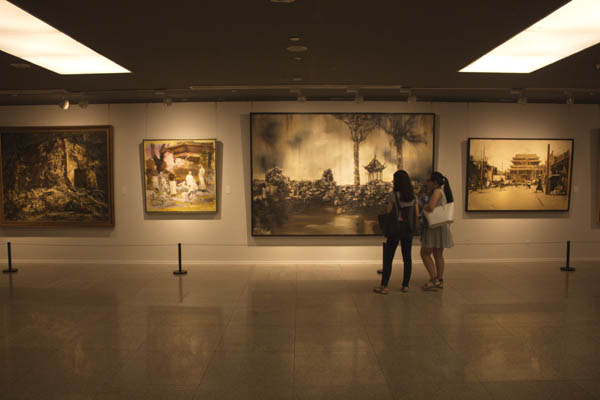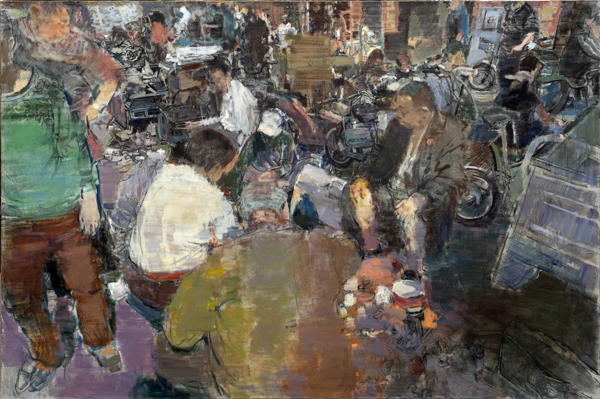Antique Market, by Zhangchun Dabao. [Photo provided to China Daily]
Chinese artists have sought to blend a Chinese temperament into their oil paintings since the genre arrived in the country a century ago.
They have tried to develop a distinctive style that reflects Chinese aesthetics. And one of the approaches they have taken is the freehand style of xieyi, which literally means drawing the spirits.
Inheritance of Cultural Spirit, an ongoing exhibition at the National Art Museum of China, looks at various attempts by painters to develop the xieyi style.
On show are more than 120 paintings by artists from across the country.
The exhibition is staged by the Beijing-based Research Institute of Contemporary Chinese Xieyi Oil Painting, which was established in November.
The concept of "xieyi oil painting" was devised by painter and educator Luo Gongliu (1916-2004) in the late 1950s.
Luo, one of the founders of the Central Academy of Fine Arts, was sent to study of oil painting at the I. Repin St. Petersburg State Academy of Painting, Sculpture and Architecture from 1955 to '58. There, he realized that Chinese painters had to ditch their rigid technical doctrines about oil painting and blaze a trail of their own by returning to their cultural roots.
Recounting Luo's words, Dai Shihe, 68, a retired professor of the Central Academy of Fine Arts, whose paintings are also on show at the exhibition, says: "He (Luo) said that, as he gained more understanding of oil painting, he felt lost. He said it felt like that he had Western cuisine every day that he wanted Chinese porridge."
Luo then returned to Beijing to found the xieyi oil painting school, going beyond the classic ink-and-brush tradition.
In xieyi, painters are asked to go beyond the physical details of the objects.

The exhibition at the National Art Museum of China features more than 120 xieyi oil paintings. [Photo provided to China Daily]
Xu Li, another artist featured at the exhibition, says the xieyi spirit is in different categories of Chinese art, including pottery and bronze ware, sculptures from the Han (206 BC-AD220) and the Tang (618-907) dynasties, literati paintings and folk art.
He says that this empowered generations of Chinese artists to enrich their output, and the current exhibition showcases their efforts.
Fan Di'an, the head of the Central Academy of Fine Arts, who curated the exhibition, says that while artists are nurtured by cultural traditions, their paintings also focus on the grassroots.
Beijing-based painter Duan Zhengqu dwells on the relationship between people and the Earth in northern China. The 59-year-old's painting, Mirror, exhibits the vitality of human beings when they have to cope with a tough natural environment.
A native of landlocked Henan province, Duan says his inspiration comes from northwestern China. He says that he has found energy in the Yellow Plateau and was moved by the villagers who are tough and tolerant.
Dai says another aspect of the xieyi school is to hail predecessors' art.
"They were not only skillful painters. They were giants," he says.
"Their morality makes their works outstanding even when they are only palm-sized. And their spirit is what we should retain in our creations."
If you go
9 am-5 pm, through July 4. National Art Museum of China, 1 Wusi Dajie, Dongcheng district, Beijing. 010-6400-1476


















